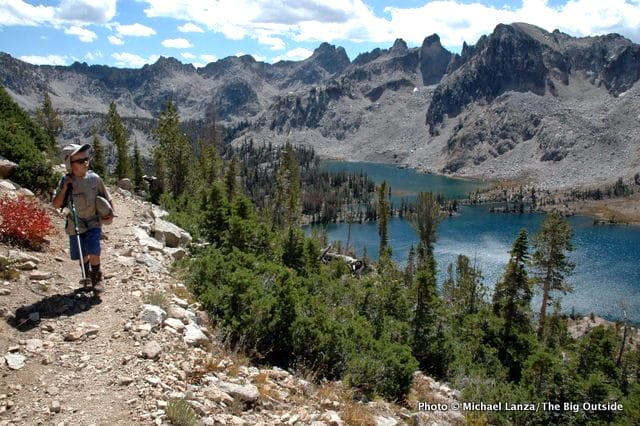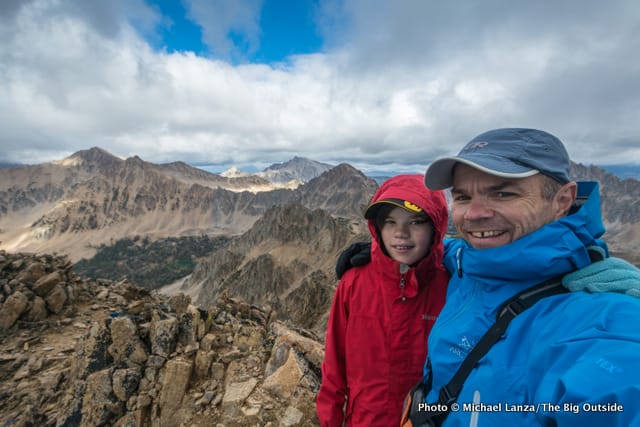
The risks and rewards of raising a young explorer
The risks and rewards of raising a young explorer
The ranger in the office of Idaho’s Sawtooth National Recreation Area frowned skeptically when I explained my plans to backpack an 18-mile loop to Alice and Toxaway lakes. He looked down at my son, Nate, then six years old and about 40 pounds—less than the weight of the pack I’d carry—clutching his stuffed dolphin. (“It’s the rare alpine dolphin,” he’d say, grinning, to anyone we met in the mountains.)
“You know, that’s a pretty rugged hike,” the ranger told me—his polite way of suggesting he considered me a fool for putting my son in harm’s way. I know he meant well. But Nate and I finished the hike not only without a problem, but a day sooner than we planned: he wanted an extra day to kayak on Redfish Lake.
It was the first of what would become annual father-son “Boy Trips”—a tradition I’ve also established with my daughter. Over many journeys since, I’ve learned that strangers will often react to the sight of my family on a remote trail as if my wife and I were encouraging our children to ride alligators bareback.
I’m reminded of the hiker we passed on Zion’s West Rim while backpacking with our son and daughter, then eight and six. “You know it gets cold up there at night, right?” he warned us. (The low that night was about 50° F.) Or the open-mouthed expressions of people staring out the windows of the shuttle that dropped us off with our cross-country skis at a trailhead in Yellowstone.

I can understand their worry. My wife and I have many serious conversations about risk and appropriate choices for our kids: we’ll occasionally abandon Plan A for Plan B, or turn back altogether when conditions demand it. But our family has safely backpacked together in national parks from the Tetons to Sequoia, paddled among alligators (without riding any) in the Everglades, rappelled into slot canyons, and sea kayaked for days in Alaska’s Glacier Bay National Park.
Unfortunately, my kids are anomalies. We live in a time when just eight percent of American children age 12 to 15 are active for even an hour a day. My son’s friends mostly interact online rather than playing together in person—never mind outdoors. I look at my phone bill and see that my seventh-grade daughter sends over 600 texts a month.
The United States is a nation founded in wilderness—it’s the country that introduced the concept of national parks to the world. But most American children today have little or no exposure to wilderness. I think we parents today should worry less about nature’s hazards and more about what sort of adults our kids will become if they spend so little time outdoors.

I’m not blind to the hazards of the outdoor activities I do with my family. But I believe that nature offers children lessons applicable to every aspect of their lives. When I take my kids rock climbing, the danger is easy to visualize. I can use that to frame a conversation about more commonplace risks that we all tend to ignore, like being in cars. And they will drive or ride in cars far more often in their lives than they will rock climb.
Nate is 15 now, an accomplished backpacker and climber currently preparing to summit Mt. Whitney. He came to me one evening recently to tell me that one of his best friends has never camped. Nate wants to take him backpacking. “I thought about the things I most like to do, and they’re all in the outdoors,” Nate told me, “and I think it would be cool to take him out there with us.”
I told him I liked that idea.
Trust For Public Land media partner Michael Lanza blogs about his outdoor adventures, including many with his family, at The Big Outside. His award-winning book Before They're Gone—A Family's Year-Long Quest to Explore America's Most Endangered National Parks, chronicles his family’s wilderness adventures in national parks threatened by climate change.
Despite the importance and popularity of our forests, they face unprecedented threats. Take action now and urge Congress to protect our country’s forests by signing our petition today!


Donate to become a member, and you’ll receive a subscription to Land&People magazine, our biannual publication featuring exclusive, inspiring stories about our work connecting everyone to the outdoors.
See how our supporters are helping us connect people to the outdoors across the country.


